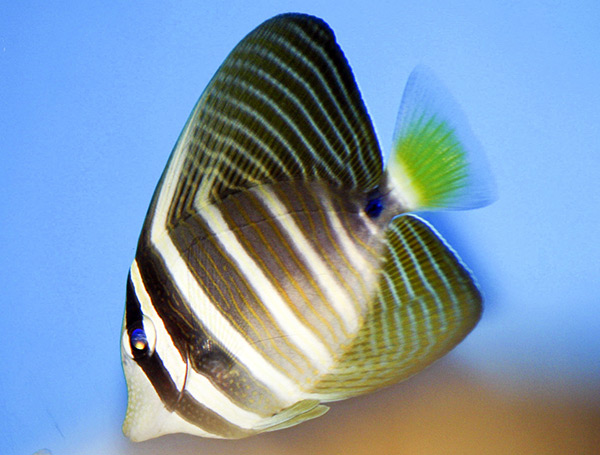The Pacific sailfin tang (Zebrasoma velifer), not to be confused with its Red Sea namesake (Zebrasoma desjardinii), is a fish with many attributes that make it desirable to marine aquarium hobbyists—it’s attractive, hardy, bold, easy to feed, etc. But don’t be deceived by that cute little specimen on display at your LFS. Z. velifer also gets really big rather quickly, so a large tank is essential if you plan to keep this species long term.
Physical traits
Z. velifer exhibits the oval body shape, pointed snout, and sail-like dorsal and anal fins typical of the members of its genera. This last characteristic is especially pronounced on Z. velifer, thus its common name. In fact, when its dorsal and anal fins are fully extended, this species can appear downright massive. A scalpel-like spine is situated on each side of the caudal peduncle. The maximum length for this species is over 15 inches.
This fish’s coloration consists of alternating vertical bands of tan/brown and yellow/white with subtle striations running through the brown bands and forming a lattice-like pattern through the dorsal and anal fins. Not the brightest-colored fish in the sea, perhaps (and one could argue that its Red Sea cousin is prettier), but it’s impressive to look at nonetheless.
Feeding
In nature, Z. velifer feeds on macroalgae, so its diet in captivity should reflect this. Aquarium specimens will accept most foods offered, but their menu should consist primarily of choices like dried marine algae sheets, spirulina pellets, spirulina flakes, frozen herbivore formulations, etc. Frequent daily feedings are recommended.

Housing
Did I mention this species gets large and grows quickly? It’s also highly energetic and needs plenty of swimming space in addition to copious rockwork to graze on and refuge in. That should tell you Z. velifer needs a big tank. I’d put bare-minimum housing somewhere in the vicinity of 180 to 200 gallons (with bigger being better), and the aquascaping/tank footprint should allow plenty of horizontal “running room” and the ability to turn around freely at either end when full-sized.
Compatibility
The Pacific sailfin tang may behave aggressively toward conspecifics and closely related species but isn’t overly pugnacious toward dissimilar piscine tankmates otherwise. As far as inclusion in reef systems is concerned, Z. velifer is generally a suitable candidate, though as with many algae-grazing species kept in aquaria, it may nip at coral polyps as it grazes from rock to rock.



